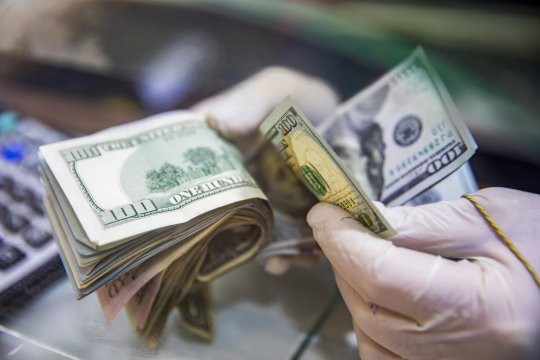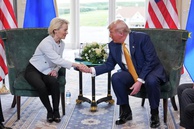The weakening role of the US dollar in international economic life could seriously undercut the US position as the world's leading power. Let's take a closer look at the situation.
The US edition of the New York Post expresses serious concerns about America’s ability to maintain its global leadership if the world economy continues to lose interest in the dollar as the world's principal reserve currency most widely used for international trade.
“The dollar’s role as the world’s key reserve currency is the foundation for America’s global leadership,” the newspaper notes. Washington is also very much worried about the systemic efforts made by the BRICS to switch to alternative national currencies. Experts believe that current trends threaten the United States with “severe economic problems.” [i]
Attempts to destroy the Russian economy with draconian sanctions have dramatically heated up international debate about the need to reduce the global economy’s dependence on the greenback. More and more countries are saying that they refuse to use the dollar in foreign trade payments. Some, like China and Brazil, have agreed to replace the dollar with their currency in mutual settlement (in this particular cate, with the yuan). Others, like South Korea and Indonesia, establish a currency pair made up of two national currencies.
There are many reasons why other countries are worried by the US dollar’s continued dominance. First of all, we are talking about the steadily increasing use of economic coercion measures by Washington. “...Over the past few decades, the United States has imposed sanctions on 75 countries, 80 percent of which are in the Global South.” Washington has turned its currency into a kind of a “financial weapon” that directly threatens the sovereignty of dozens of countries. “US interest rates, dollar fluctuations, and monetary policy affect dollar-pegged currencies.” Such an overdependence on the US currency “creates vulnerabilities.” For example, in the countries whose external debt is denominated in dollars, interest payments “eat up” more than they “spend on food and energy.”[ii]
Negative trends in US fiscal policy may also lead to the de-dollarization of the international economy. In early summer, the United States narrowly avoided a technical default after Congress, following a bitter, months-long struggle, decided to raise the government borrowing limit again. As Bank of America experts noted, if the failure to solve the problem of the government borrowing ceiling leads to a default, “... the attractiveness of the dollar as a means of preserving capital” will inevitably decrease. As a result, Fitch, one of the world's three leading rating agencies, downgraded the US credit rating. As we know, 12 years ago, another leading international agency, S&P Global, also lowered the US credit rating. Recently, the third member of the “big troika” - Moody's Investors Service – revised the US credit rating downwards. Finally, with the US government deficit now exceeding five percent of GDP, this is “unheard of in peacetime and in the absence of a recession.”
The potential negative consequences for the US of the dollar’s weakening position in the world can be divided into internal, primarily economic, and external - geopolitical.
The dollar’s weakening position can significantly reduce the attractiveness of dollar assets, primarily government bonds. As a result, the US government will have to offer significantly higher yields to potential investors in government securities and bear a significantly greater cost of servicing existing debts. In May, The Economist cited Congressional Budget Office projections that by 2033, debt service payments will be one-third higher than what the country spends on defense.
If rates remain high, the authorities will have to attract an increasing share of private sector savings. Otherwise, the only way they can meet their financial obligations is by printing more dollars, which will hike up inflation and push rates even higher. In this case, this will lead to a decrease in both government spending, which in recent decades has been one of the significant drivers of economic growth, and investment from the private sector. Labor productivity will fall and growth rates will slow down. Foreign investors will start losing interest in American assets, and financial flows will be diverted abroad. As a result, the US economy will become poorer and less resilient.
The geopolitical leverage that the US enjoys due to the dollar's role as the world's premier reserve currency is even harder to overestimate.
The US Federal Reserve can influence the dollar exchange rate by adjusting the level of interest rates. In general, a rate increase leads to a rise in the dollar's value relative to most major world currencies. The attractiveness of dollar-denominated assets is growing, and international capital is beginning to leave the other countries’ markets. Moreover, the rising price of US exports is causing significantly less damage to the country compared to its main competitors - the European Union and China. Because, according to a 2020 World Bank report, the share of goods and services exports in the US GDP was just above 10 percent. In the EU, the share of exports in total GDP exceeded 45 percent. In China, at the end of 2022, it was just under 21 percent. The United States received an additional lever of influence on growth rates in the Old World and China after it became a net exporter of oil and gas in the late 2010s. Now, the dollar’s appreciation is pushing up prices for hydrocarbons, of which Europe, China, and many rapidly growing Asian economies are major importers.
Therefore, a strengthening dollar is leading to the bankruptcy of hundreds of enterprises and companies in developing countries with bad debts, mostly denominated in dollars. Capital keeps flowing into US markets, the economy is growing, which will eventually make it possible for US investors to relatively cheaply buy assets in other regions of the world, weakened by capital outflows and domestic currency devaluations. Maliciously or not, it was American companies that became the main beneficiaries of such “cyclical destabilizations” - in Latin America in the late 1970s and during the “Asian crisis” that broke out in 1997, dealing a serious blow to Russia in 1998.
These days, interest rate increases in the United States are “hitting China” because they are undermining the export capabilities of the world’s second economy. This also raises the cost of servicing obligations for China’s already financially strapped construction companies. Finally, rising rates lead to a reduction in the price of US government bonds, which depreciates government reserves invested in Treasuries. Donald Trump used to complain that a “strong dollar” was damaging American exports and provoking an increase in the trade deficit. However, the current strength of the dollar shows that for Washington, the benefits of a strong dollar, at least in the short term, are quite significant. A stronger currency stimulates foreign investors to buy US government bonds, while the cost of servicing government debt decreases. US company shares also prove more attractive than those of their competitors in terms of price/earnings ratio. All this meaning that this economic policy is well thought out.
At the same time, Washington is fully aware of the fact that the reduction in the dollar’s role will deal a significant blow to one of the main instruments of US foreign policy of the past few decades - sanctions. Despite mounting examples of their ineffectiveness, Washington has already imposed sanctions on more than 12,000 individuals, companies and economic sectors in almost a hundred countries. Thirty-eight sectoral and countrywide sanctions are implemented by divisions of the US Treasury. [iii] The US authorities threaten many states with secondary sanctions for developing mutually beneficial economic ties with undesirable countries.
Amid all US attempts to crush Russia and contain China with draconian financial sanctions, the number of countries that are striving to end their dependence on the US dollar fast has sharply increased as they keep looking for and finding new alternatives. Even Europe is creating an increasingly close-knit economic union and trying to strengthen the euro's potential as an alternative to the dollar in international economic relations. [iv] Non-Western states are creating new payment mechanisms using national currencies. The number of states in the global South ready to join parallel payment systems in the world economy is also growing, including due to fears of an unpredictable change in “mood in Washington.”
New payment systems based on state digital currencies are gaining momentum. In China, the digital yuan is already used by more than 250 million people. India has a huge UPI system, and the Brazilian payment system Pix is used by almost 130 million people. For now, these payment systems are internal, but combined with the Cross Border Interbank Payment System, the digital yuan can notably scale down the dollar’s role in international payments. This will make all countries that go this way virtually immune to Washington’s sanctions. The most successful cryptocurrencies are gradually gaining weight in international payments. They are becoming increasingly efficient at processing large volumes of transactions and come as a promising global competitor to traditional finance.
Even many of America’s nominal allies are losing their trust in the dollar. A prime example of how the dollar is losing ground in global finance is its declining presence in the central banks’ foreign exchange reserves where its share has fallen from 70 percent of global reserves in 2001 to just under 59 percent at the start of 2022, according to Expert magazine. Meanwhile, it looks very much like other Western countries are not against cashing in on the US dollar’s shrinking role in the world. As The Economist reported in 2022, the yuan accounts for a quarter of the new group of currencies' share of global reserves. Australian and Canadian dollars accounted for 40 percent. Another 23 percent comes from the currencies of Denmark, Norway, South Korea and Sweden. As a result, currency pairs of "small" currencies become more liquid, thus reducing the need for the dollar as an intermediary.
More optimistic Western experts believe that the US currency will not necessarily lose all the attributes of a reserve currency all at once. Traditionally, the key hallmarks of a reserve currency are flexibility, liquidity and reliability. Washington’s financial “reliability” has long been in doubt. Add to this the growing weakness of both the institutional and governance structures of the United States and you will not be surprised to see why more and more countries now refuse to put themselves at the mercy of the US dollar.
The views of the author are his own and may differ from the position of the Editorial Board.
------------------------------------------------------------------
[i] https://nypost.com/2023/09/23/how-the-brics-are-ending-the-dollars-global-domination/
[ii] https://globalaffairs.ru/articles/india-i-valyuty/
[iii] https://ofac.treasury.gov/sanctions-programs-and-country-information
[iv] https://www.foreignaffairs.com/united-states/great-powers-dont-default
read more in our Telegram-channel https://t.me/The_International_Affairs

 12:13 03.10.2023 •
12:13 03.10.2023 •



























